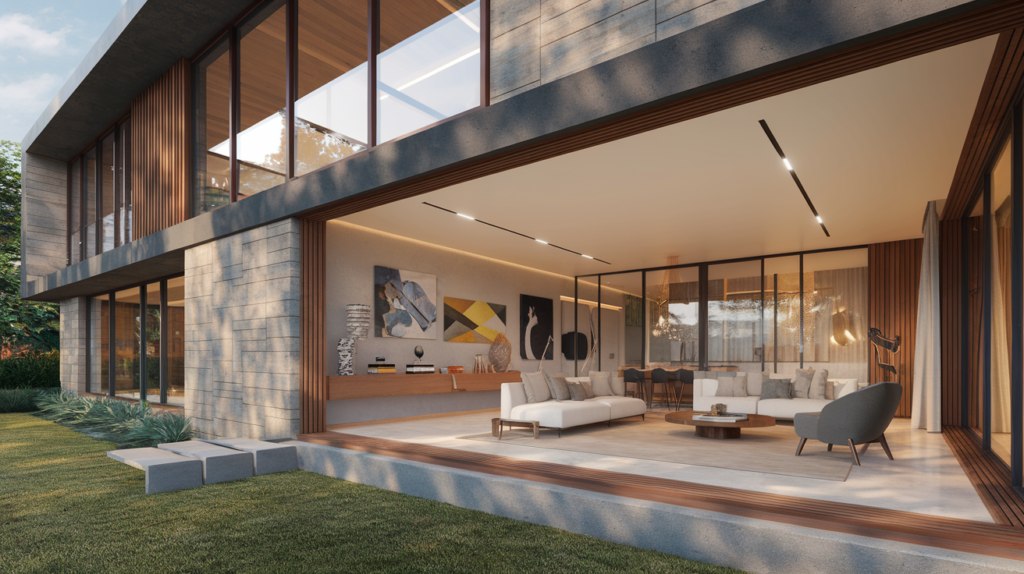The Importance of Harmony in Design
Designing a home is much more than selecting the right furniture, colors, or landscaping. It’s about creating a seamless transition between the interior and exterior spaces that resonates with the overall aesthetic and functional goals of the homeowner. The concept of balancing interior and exterior design is crucial in ensuring that a home is not only visually appealing but also coherent in its design language. This approach to design is essential in creating spaces that feel connected, both physically and emotionally.
Understanding the Fundamentals of Interior Design
Interior design focuses on the elements within the walls of a home. It involves the selection and arrangement of furniture, lighting, colors, textures, and materials to create a space that is functional, comfortable, and visually pleasing.
- Furniture and Layout: The choice of furniture plays a significant role in defining the character of a room. Whether opting for modern, minimalist pieces or classic, ornate furnishings, the furniture should reflect the homeowner’s taste and lifestyle. The layout is equally important; it determines the flow of movement and how the space is used.
- Color Schemes and Textures: Colors and textures can significantly impact the mood of a space. While neutral tones like beige and gray create a calm and sophisticated atmosphere, bold colors like red and blue can energize a room. Similarly, the use of various textures—such as smooth silk, rough stone, or soft wool—adds depth and interest to the design.
- Lighting: Lighting is a critical component of interior design. Natural light can make a space feel open and airy, while artificial lighting can create warmth and intimacy. The placement of lights, as well as the choice of fixtures, should enhance the overall design and highlight key areas within a room.
The Role of Exterior Design in Home Aesthetics
Exterior design is the first impression of a home. It encompasses everything outside the walls, including the architecture, landscaping, and exterior finishes. A well-designed exterior not only adds curb appeal but also sets the tone for what’s inside.
- Architectural Style: The architecture of a home should reflect both personal style and the surrounding environment. Whether it’s a contemporary design with clean lines and large windows, a traditional colonial with symmetry and formality, or a rustic cottage with natural materials, the architecture forms the backbone of exterior design.
- Landscaping: Landscaping is integral to exterior design. It includes the arrangement of plants, trees, and other elements like pathways, fountains, and outdoor furniture. Thoughtful landscaping can enhance the beauty of the home and create a welcoming outdoor space that complements the interior.
- Exterior Finishes and Materials: The choice of exterior materials and finishes, such as brick, stone, wood, or siding, contributes to the overall look and durability of the home. These materials should be selected not only for their aesthetic appeal but also for their ability to withstand the local climate. Choices like brick, stone, wood, or siding contribute to durability and look and the best exterior outdoor tile design can enhance features such as pathways and patios.
Creating a Seamless Transition Between Interior and Exterior Spaces
Achieving a balance between interior and exterior design requires careful planning and attention to detail. The goal is to create a sense of continuity, so the transition between the inside and outside feels natural and harmonious.
- Consistent Color Palette: Using a consistent color palette for both interior and exterior spaces can tie the design together. For example, if the exterior features warm earth tones, incorporating similar hues in the interior through paint, fabrics, or accessories can create a cohesive look.
- Complementary Materials: Selecting materials that complement each other for both the interior and exterior can enhance the connection between the spaces. For instance, if natural stone is used on the exterior, consider incorporating it inside the home through a fireplace, accent wall, or flooring.
- Indoor-Outdoor Living: Designing spaces that blur the lines between indoors and outdoors is a popular trend in modern architecture. Large sliding doors, covered patios, and outdoor kitchens are examples of how homes can be designed to encourage outdoor living while still being connected to the interior. These spaces should be designed with similar styles, colors, and materials to ensure a smooth transition.
Practical Tips for Balancing Interior and Exterior Design
Balancing interior and exterior design is both an art and a science. Here are some practical tips to help you achieve this balance:
- Plan with Purpose: Start with a clear vision of how you want your home to look and feel, both inside and out. Consider how the two spaces will interact and influence each other. A well-thought-out plan will guide your design decisions and help you stay true to your vision.
- Focus on Flow: The flow between interior and exterior spaces should be seamless. Consider the layout of your home and how the spaces connect. For example, a kitchen that opens onto a patio can create a functional and social space for entertaining.
- Use Nature as Inspiration: Let the natural surroundings inspire your design choices. Whether it’s the colors of the landscape, the textures of the terrain, or the local climate, incorporating elements of nature into your design can create a sense of harmony between your home and its environment.
The Impact of Thoughtful Design
The art of balancing interior and exterior design is about creating a unified and cohesive look that enhances the beauty and functionality of a home. By considering both the interior and exterior as parts of a whole, you can design spaces that are not only visually appealing but also in tune with the lifestyle and needs of the occupants.
A thoughtful approach to design, considering every detail from the choice of materials to the flow of spaces, ensures that your home is not just a place to live but a reflection of who you are. While the creative aspects of design are essential, it’s also important to recognize the role of professionals, like civil construction engineers, who ensure that your vision is structurally sound and feasible. Balancing aesthetics with functionality and safety is the key to creating a home that stands the test of time.



